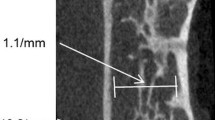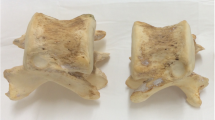Abstract
Summary
This study employed microCT to investigate whether image resolution affects bone structural parameters differently in healthy normal and osteoporotic trabecular bone. With increasing image voxel size, the originally detected differences between sample groups diminished. The results suggest that structural differences may not be reliably detected with clinical scanners.
Introduction
Structural parameters of bone reflect its health status, but are highly dependent on the image resolution. We hypothesized that image resolution affects bone structural parameters differently in normal and osteoporotic trabecular bone.
Methods
Human trabecular bone samples from the iliac crest and the knee were analyzed (normal n = 11, osteoporotic n = 15) using a high-resolution microCT (14 or 18 µm voxel sizes). Images were re-sampled to voxel sizes 1–16 times larger than the original image and thresholded with global or local adaptive algorithms. Absolute and normalized values of each structural parameter were calculated, and the effect of decreasing image resolution was compared between the normal and osteoporotic samples.
Results
Normal and osteoporotic samples had different (p < 0.05) absolute bone volume fractions. However, the normalized values showed that the osteoporotic samples were more prone to errors (p < 0.05) with increased voxel size. The absolute values of trabecular number, trabecular separation, degree of anisotropy, and structure model index were different between the groups at the original voxel size (p < 0.05), but at voxel sizes between 60 and 110 µm, those differences were no longer significant.
Conclusions
The results suggest that structural differences between osteoporotic and normal trabecular bone may not be reliably detected with clinical CT scanners providing image voxel sizes above 100 µm.




Similar content being viewed by others
References
Cooper C (1999) Epidemiology of osteoporosis. Osteoporos Int 9(Suppl 2):S2–S8
Compston JE, Papapoulos SE, Blanchard F (1998) Report on osteoporosis in the European Community: current status and recommendations for the future. Working Party from European Union Member States. Osteoporos Int 8:531–534
Melton LJ 3rd, Atkinson EJ, O'Fallon WM, Wahner HW, Riggs BL (1993) Long-term fracture prediction by bone mineral assessed at different skeletal sites. J Bone Miner Res 8:1227–1233
Burr DB (2002) Bone material properties and mineral matrix contributions to fracture risk or age in women and men. J Musculoskelet Neuronal Interact 2:201–204
Delmas PD, Seeman E (2004) Changes in bone mineral density explain little of the reduction in vertebral or nonvertebral fracture risk with anti-resorptive therapy. Bone 34:599–604
Astrand J, Thorngren KG, Tagil M (2006) One fracture is enough! Experience with a prospective and consecutive osteoporosis screening program with 239 fracture patients. Acta Orthop 77:3–8
World Health Organization Group (1994) Assessment of fracture risk and its application to screening for postmenopausal osteoporosis. World Health Organization, Geneva
Pasco JA, Seeman E, Henry MJ, Merriman EN, Nicholson GC, Kotowicz MA (2006) The population burden of fractures originates in women with osteopenia, not osteoporosis. Osteoporos Int 17:1404–1409
Greenspan S (2004) Osteoporosis. In: Andreoli TE (ed) Cecil essentials of medicine. W.B. Saunders, Philadelphia, pp 715–722
Fields AJ, Eswaran SK, Jekir MG, Keaveny TM (2009) Role of trabecular microarchitecture in whole-vertebral body biomechanical behavior. J Bone Miner Res 24:1523–1530
Dalle Carbonare L, Giannini S (2004) Bone microarchitecture as an important determinant of bone strength. J Endocrinol Invest 27:99–105
Newitt DC, Majumdar S, van Rietbergen B, von Ingersleben G, Harris ST, Genant HK, Chesnut C, Garnero P, MacDonald B (2002) In vivo assessment of architecture and micro-finite element analysis derived indices of mechanical properties of trabecular bone in the radius. Osteoporos Int 13:6–17
Boyd SK, Davison P, Muller R, Gasser JA (2006) Monitoring individual morphological changes over time in ovariectomized rats by in vivo micro-computed tomography. Bone 39:854–862
Carballido-Gamio J, Majumdar S (2006) Clinical utility of microarchitecture measurements of trabecular bone. Curr Osteoporos Rep 4:64–70
Ruegsegger P, Koller B, Muller R (1996) A microtomographic system for the nondestructive evaluation of bone architecture. Calcif Tissue Int 58:24–29
Campbell GM, Buie HR, Boyd SK (2008) Signs of irreversible architectural changes occur early in the development of experimental osteoporosis as assessed by in vivo micro-CT. Osteoporos Int 19:1409–1419
Gasser JA, Ingold P, Grosios K, Laib A, Hammerle S, Koller B (2005) Noninvasive monitoring of changes in structural cancellous bone parameters with a novel prototype micro-CT. J Bone Miner Metab 23:90–96, Suppl
Thomsen JS, Laib A, Koller B, Prohaska S, Mosekilde L, Gowin W (2005) Stereological measures of trabecular bone structure: comparison of 3D micro computed tomography with 2D histological sections in human proximal tibial bone biopsies. J Microsc 218:171–179
Chappard D, Retailleau-Gaborit N, Legrand E, Basle MF, Audran M (2005) Comparison insight bone measurements by histomorphometry and microCT. J Bone Miner Res 20:1177–1184
Akhter MP, Lappe JM, Davies KM, Recker RR (2007) Transmenopausal changes in the trabecular bone structure. Bone 41:111–116
Brouwers JE, Lambers FM, Gasser JA, van Rietbergen B, Huiskes R (2008) Bone degeneration and recovery after early and late bisphosphonate treatment of ovariectomized wistar rats assessed by in vivo micro-computed tomography. Calcif Tissue Int 82:202–211
Kothari M, Keaveny TM, Lin JC, Newitt DC, Genant HK, Majumdar S (1998) Impact of spatial resolution on the prediction of trabecular architecture parameters. Bone 22:437–443
Muller R, Koller B, Hildebrand T, Laib A, Gianolini S, Ruegsegger P (1996) Resolution dependency of microstructural properties of cancellous bone based on three-dimensional mu-tomography. Technol Health Care 4:113–119
Sode M, Burghardt AJ, Nissenson RA, Majumdar S (2008) Resolution dependence of the non-metric trabecular structure indices. Bone 42:728–736
Kim DG, Christopherson GT, Dong XN, Fyhrie DP, Yeni YN (2004) The effect of microcomputed tomography scanning and reconstruction voxel size on the accuracy of stereological measurements in human cancellous bone. Bone 35:1375–1382
Waarsing JH, Day JS, Weinans H (2004) An improved segmentation method for in vivo microCT imaging. J Bone Miner Res 19:1640–1650
Kazakia GJ, Hyun B, Burghardt AJ, Krug R, Newitt DC, de Papp AE, Link TM, Majumdar S (2008) In vivo determination of bone structure in postmenopausal women: a comparison of HR-pQCT and high-field MR imaging. J Bone Miner Res 23:463–474
Boutroy S, Bouxsein ML, Munoz F, Delmas PD (2005) In vivo assessment of trabecular bone microarchitecture by high-resolution peripheral quantitative computed tomography. J Clin Endocrinol Metab 90:6508–6515
Mueller TL, Stauber M, Kohler T, Eckstein F, Muller R, van Lenthe GH (2009) Non-invasive bone competence analysis by high-resolution pQCT: an in vitro reproducibility study on structural and mechanical properties at the human radius. Bone 44:364–371
Boutroy S, Van Rietbergen B, Sornay-Rendu E, Munoz F, Bouxsein ML, Delmas PD (2008) Finite element analysis based on in vivo HR-pQCT images of the distal radius is associated with wrist fracture in postmenopausal women. J Bone Miner Res 23:392–399
Diederichs G, Link T, Marie K, Huber M, Rogalla P, Burghardt A, Majumdar S, Issever A (2008) Feasibility of measuring trabecular bone structure of the proximal femur using 64-slice multidetector computed tomography in a clinical setting. Calcif Tissue Int 83:332–341
Tamminen I, Aula A, Isaksson H, Jurvelin JS, Kröger H (2009) Reproducibility and agreement of microCT and histomorphometry depends on the metabolic status of human trabecular bone. Transactions of 55th annual meeting of the Orthopaedic Research Society, Las Vegas, Nevada, USA
Hakulinen MA, Day JS, Toyras J, Weinans H, Jurvelin JS (2006) Ultrasonic characterization of human trabecular bone microstructure. Phys Med Biol 51:1633–1648
Hildebrand T, Ruegsegger P (1997) Quantification of bone microarchitecture with the structure model index. Comput Methods Biomech Biomed Engin 1:15–23
Odgaard A, Kabel J, van Rietbergen B, Dalstra M, Huiskes R (1997) Fabric and elastic principal directions of cancellous bone are closely related. J Biomech 30:487–495
Bland JM, Altman DG (1986) Statistical methods for assessing agreement between two methods of clinical measurement. Lancet 1:307–310
Chappard C, Marchadier A, Benhamou L (2008) Interindividual and intraspecimen variability of 3-D bone microarchitectural parameters in iliac crest biopsies imaged by conventional micro-computed tomography. J Bone Miner Metab 26:506–513
Eckstein F, Matsuura M, Kuhn V, Priemel M, Muller R, Link TM, Lochmuller EM (2007) Sex differences of human trabecular bone microstructure in aging are site-dependent. J Bone Miner Res 22:817–824
Acknowledgements
Financial support from the Academy of Finland (128863), Kuopio University Hospital (EVO 5231), and the European Commission (BONEQUAL-219980) is gratefully acknowledged.
Conflicts of interest
None.
Author information
Authors and Affiliations
Corresponding author
Rights and permissions
About this article
Cite this article
Isaksson, H., Töyräs, J., Hakulinen, M. et al. Structural parameters of normal and osteoporotic human trabecular bone are affected differently by microCT image resolution. Osteoporos Int 22, 167–177 (2011). https://doi.org/10.1007/s00198-010-1219-0
Received:
Accepted:
Published:
Issue Date:
DOI: https://doi.org/10.1007/s00198-010-1219-0




